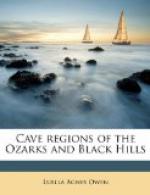The atmosphere in Marble Cave has the peculiar bracing and invigorating quality common to the majority of caves, that seems almost to defy fatigue and encourage exertion that under ordinary conditions would be impossible.
After the exertion necessary in the warmer portions of the cave, the temperature of 42 deg. proved rather low for comfort and finally was admitted to be a sufficient reason for either leaving the cave or sending out for the wraps. Slowly and reluctantly the party walked up the long winding path to the summit of the Hill where the stairway finds support, stopping many times to admire again the perfect curves and fine color-tones of that wonderful high arch—within a mountain yet softly radiant with the light of day.
Still lingering regretfully among the fern-decked rocks before quite finishing the ascent to the actual outside world, the mercury lost little time in registering eighty degrees.
Since no official, or even approximately correct map of Marble Cave has yet been published, and the desirability of maps is particularly urged by Monsieur E.A. Martel, a special effort was made to secure one, which was accompanied by the following remarks from Mr. Prince in regard to its incompleteness:
“There are several passages and rooms which do not appear on the map, though some of them are well known, but have not been surveyed and platted.
“Much further exploration is possible in this great cavern. Lost River Canon ends abruptly in a bank of red clay, the volume of water being undiminished. The water from the Great Fall flows by a small serpentine into a passage which has never been followed up; its entrance being several hundred feet higher than the nearest water level.”
Unfortunately the quantity of water in the cave at the time of the visit just described was so unusually great as to render the Lost River Canon trip impossible.
During the previous season the cave and its surroundings were visited by a prominent naturalist who appears to have been delightfully liberal in the diffusion of scientific knowledge and the explanations of methods of pursuing investigations. His practical instruction in snake catching is particularly interesting as it was never before introduced into this state, where the copperhead and rattler are known to have survived among the fittest. Seeing a snake hole and desiring information as to the family record of the proprietor, he inserted a finger, and while waiting for results explained that there is no better way to secure a specimen, as the enraged reptile will fasten its fangs into the intruding member and then can be easily withdrawn. It is a pleasure to state that even snakes recognize the claims of friendship, and no injury was experienced.[2]
In the vicinity of Marble Cave there are several choice varieties of onyx and marble, among them a rare and beautiful onyx in black and yellow. The coloring, tinting and banding of onyx seem generally to be regarded as one of the unexplainable mysteries of nature, but is in reality an extremely simple process that can be easily studied in any active cave.




